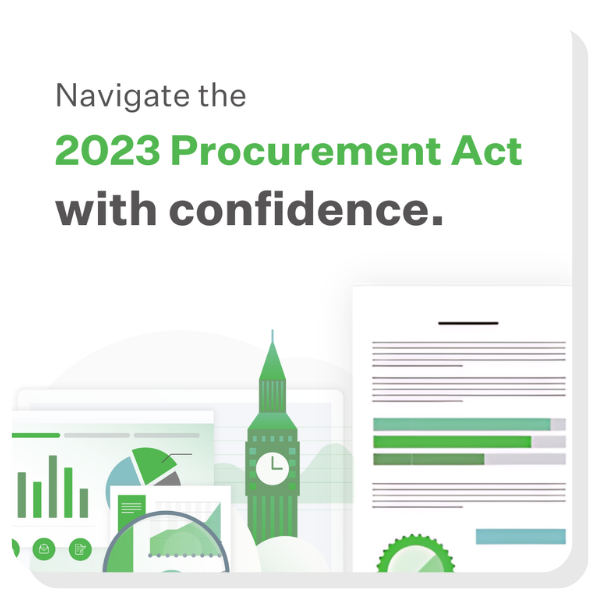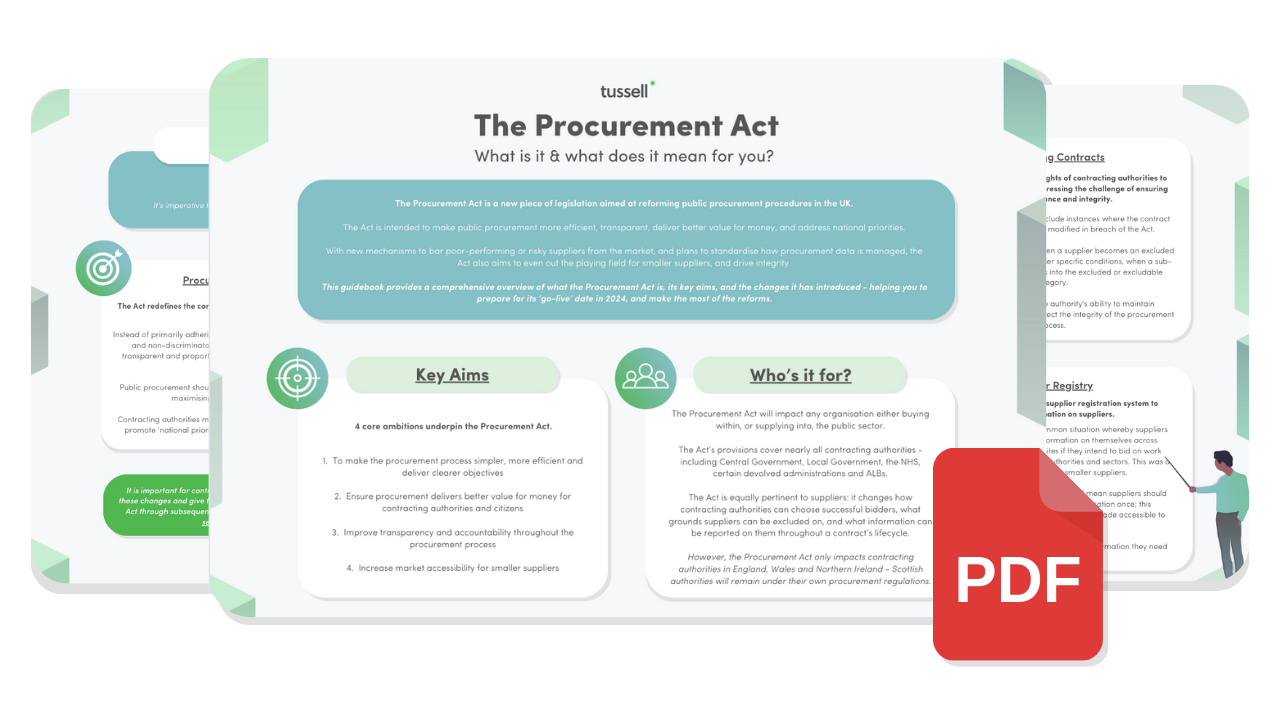In FY 23/24, over 6,100 Prior Information Notices (PINs) worth an estimated £207b were published by the public sector to alert the market of upcoming opportunities.
However, with the 2023 Procurement Act set to go live on February 24th 2025, Prior Information Notices will soon be a thing of the past.
This article takes a look at the new notice type replacing PINs - the Planned Procurement Notice.
Skip ahead to read about:
- What information is included on Planned Procurement Notices?
-
What are the advantages and disadvantages of Planned Procurement Notices for buyers and suppliers?
- Conclusion
***

Don't fancy reading? Watch the video version of this blog!
This article is part of a series of articles on the 2023 Procurement Act.
Head to Tussell's Procurement Act Hub for all the information and resources you need to get Procurement Act ready.
🔎 What are PINs?
Prior information notices (PINs) are public notices used by government buyers wishing to procure complex products and services.
They signal to the wider market that the buyer has a specific upcoming commercial need. When published online, a PIN formally marks that a preliminary market consultation has begun.
 Source: Tussell
Source: Tussell
Suppliers use PINs to anticipate upcoming opportunities in the public sector.
Each new PIN marks an opportunity for the buyer (or customer) and supplier to explain more about themselves and their respective organisations before the formal procurement process begins.
PINs also provide an opportunity for each party to provide different perspectives on the outcome they'd like to see as a result of the procurement, given their expertise in the area.
Planned Procurement Notices and Preliminary Market Engagement Notices are set to replace PINs on February 24th 2025.
🤔 What are Planned Procurement Notices?
Much like PINs, Planned Procurement Notices are an optional notice type that contracting authorities can use in the pre-procurement stage to provide advanced notice of an upcoming procurement.
Designed to give as much information to the market as possible, Planned Procurement Notices enable potentially interested suppliers to determine in advance if an upcoming procurement is something that they might wish to bid for.
The new notice type is intended to give suppliers more time to prepare for bidding.
As such, Planned Procurement Notices may be published anytime between 40 days and 1 year before the publication of an official tender notice.
❓ What are Preliminary Market Engagement Notices?
Preliminary Market Engagement Notices are similar to Planned Procurement Notices in that they may be published by contracting authorities in the pre-procurement period.
However, unlike Planned Procurement Notices, Preliminary Market Engagement Notices are used to mark the beginning of an active market consultation process.
A Preliminary Market Engagement Notice may be published before or after a Planned Procurement Notice. Contracting authorities may also wish to publish only one - or neither - of these notice types.
Read Tussell's full explainer: What are Market Engagement Notices?
📜 What information is included on Planned Procurement Notices?
Planned Procurement Notices should contain as much information about the upcoming tender as is possible at the time of publishing.
However, the Cabinet Office recognises that 12 months before a tender notice is released, a contracting authority may be unable to provide a full list of details.
For this reason, contracting authorities are permitted to edit and update Planned Procurement Notices throughout the pre-procurement period.
Whether procurement teams will actually find the time to do this remains to be seen.
⚖️ What are the advantages and disadvantages of Planned Procurement Notices for buyers and suppliers?
Planned Procurement Notices have been designed to give suppliers as much information as possible in advance of a tender notice being published.
In theory, this should afford suppliers extra time to get their team and business ready months before an upcoming tender.
By publishing a Planned Procurement Notice and alerting the market early, buyers are permitted to reduce the length of the tendering period from 25+ days to only 10 days or more.
Critics of the Procurement Act have voiced concern that this shortened tendering period could make it harder for SMEs with smaller bidding teams to compete with larger businesses.
And, whilst advanced publishing of Planned Procurement Notices should give suppliers more notice of upcoming tenders, relaxed rules around what information needs to be included on Planned Procurement Notices may render them less useful than longer tendering periods.
Other critics of Planned Procurement Notices point out that the new notice type may be unintentionally misleading.
This is because whilst Planned Procurement Notices should be published when a contracting authority intends to publish a tender notice, contracting authorities are perfectly entitled to change their mind and are under no obligation to actually carry out the procurement.
Instead of following up a Planned Procurement Notice with a tender notice, procurement teams may wish end up procuring the contract via a dynamic market. Or, they may scrap the project altogether.
This may lead to sales teams to invest time and resources into preparation for upcoming procurements that never end up happening.
The Cabinet Office suggests that it would be 'good practice' for contracting authorities to publish a Procurement Termination Notice in instances where they decide not to go forward with the tender.
🌅 Conclusion
Experts suggest that the Procurement Act could increase transparency and demystify the public sector procurement process.
The Planned Procurement Notice is just one small piece of this puzzle.
This new notice type could give suppliers longer to prepare for future tender opportunities and allow buyers to prepare the market for upcoming procurements.
However, we will have to wait until after February 2025 to see how often and how effectively Planned Procurement Notices are used.
Whether the intended benefits of the new notice type will be fully actualised remains to be seen.
* * *
If you're worried about how the Procurement Act will affect your business you're not alone.
The Procurement Act presents the biggest change to public procurement in almost 10 years - possibly even longer.
And, whilst we can try to predict how the market will respond, nobody really knows.
Tussell provides data-driven insights on the public sector market so that, no matter how the procurement landscape changes, you'll always be ahead on the top frameworks, upcoming opportunities and trends in your market.
Book a demo with the Tussell team to learn how you can start using data to drive sales, future-proof your business and de-risk your public sector strategy.
This article is part of a series of articles on the 2023 Procurement Act.
Head to Tussell's Procurement Act Hub for all the information and resources you need to get Procurement Act ready.
Sources:
Claire Jone, Michael Corsham, Procurement Act 2023 - Where are we now? Part 2 (Birketts, https://www.birketts.co.uk/legal-update/procurement-act-2023-where-are-we-now-part-2/)
Guidance: Planned Procurement Notice (Cabinet Office, https://www.gov.uk/government/publications/procurement-act-2023-guidance-documents-define-phase/guidance-planned-procurement-notice-html#:~:text=8.,at%20the%20time%20of%20publication).)
Procurement Act 2023 (Legislation.gov, https://www.legislation.gov.uk/ukpga/2023/54/part/3/chapter/1)












.png?width=815&height=200&name=TUSSELL_Demo_CTA_Banners%20(4).png)

.png?width=815&height=200&name=TUSSELL_Demo_CTA_Banners%20(11).png)
.png?width=815&height=200&name=TUSSELL_Demo_CTA_Banners%20(6).png)
-1.png?width=450&height=330&name=Procurement%20Act%20Hub%20Graphics%20(1)-1.png)


